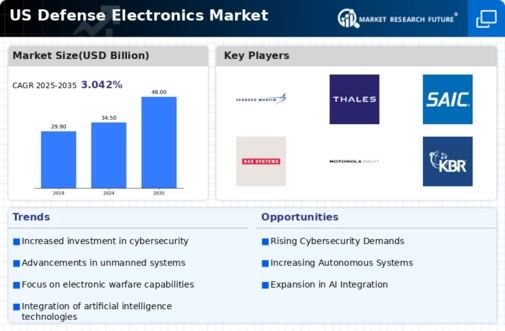Increased Defense Budgets
The defense electronics market is experiencing a notable surge due to increased defense budgets across various branches of the U.S. military. In recent years, the U.S. government has allocated substantial funds to modernize its defense capabilities, with a projected budget of approximately $750 billion for fiscal year 2026. This financial commitment is likely to enhance procurement of advanced electronic systems, including radar, communication, and surveillance technologies. As a result, defense contractors are expected to benefit from this influx of capital, driving innovation and development within the defense electronics market. The focus on upgrading existing systems and integrating new technologies is anticipated to create a robust demand for electronic components and systems, thereby propelling market growth.
Technological Advancements
Technological advancements play a pivotal role in shaping the defense electronics market. Innovations in areas such as miniaturization, signal processing, and materials science are enabling the development of more sophisticated and efficient electronic systems. For instance, the introduction of advanced semiconductor technologies has led to the creation of high-performance components that are smaller and more energy-efficient. This trend is likely to enhance the capabilities of defense systems, making them more effective in various operational scenarios. Furthermore, the integration of cutting-edge technologies, such as 5G and quantum computing, is expected to revolutionize communication and data processing within the defense electronics market. As these advancements continue to unfold, they may drive increased investment and competition among defense contractors.
Growing Geopolitical Tensions
growing geopolitical tensions significantly influence the defense electronics market., particularly in regions such as Eastern Europe and the Asia-Pacific. The U.S. has been actively responding to these tensions by enhancing its military readiness and capabilities. This has resulted in an increased demand for advanced electronic systems that can support various military operations. For example, the U.S. has been investing in electronic warfare systems and advanced missile defense technologies to counter potential threats. The market is likely to see a rise in contracts awarded to defense electronics manufacturers as the government seeks to bolster its defense posture. This trend indicates a sustained growth trajectory for the defense electronics market, driven by the need for enhanced security measures.
Focus on Modernization Programs
Modernization programs within the U.S. military are a critical driver of the defense electronics market. The Department of Defense has initiated several programs aimed at upgrading legacy systems and incorporating state-of-the-art technologies. These programs often emphasize the need for enhanced situational awareness, improved communication, and advanced weaponry. For instance, the Army's Integrated Tactical Network program aims to modernize communication systems, which is expected to create substantial opportunities for defense electronics manufacturers. The emphasis on modernization is likely to lead to increased procurement of electronic systems, thereby stimulating growth in the defense electronics market. As the military seeks to maintain technological superiority, the demand for innovative electronic solutions is anticipated to rise.
Increased Collaboration with Private Sector
The defense electronics market is witnessing an increase in collaboration between government entities and the private sector. This trend is driven by the recognition that private companies can offer innovative solutions and technologies that enhance military capabilities. Initiatives such as the Defense Innovation Unit (DIU) aim to foster partnerships with startups and established tech firms to accelerate the development of advanced electronic systems. This collaboration is likely to result in the rapid deployment of cutting-edge technologies, such as artificial intelligence and machine learning, into defense applications. As these partnerships continue to evolve, they may significantly impact the defense electronics market, leading to a more dynamic and competitive landscape.

















Leave a Comment